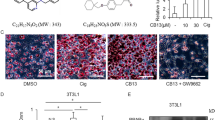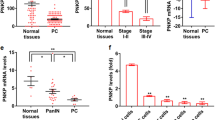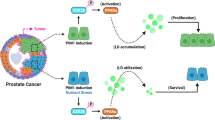Abstract
Activation of peroxisome proliferator-activated receptor (PPAR)-γ by the thiazolidinedione (TZD) class of antidiabetic drugs elicits growth inhibition in a variety of malignant tumors. We clarified the effects of TZDs on growth of human non-small cell lung carcinoma (NSCLC) cells that express endogenous PPAR-γ. Troglitazone and pioglitazone caused inhibition of cellular growth and induced apoptosis of NSCLC cells in a time- and dose-dependent manner. Subtraction cloning analysis identified that troglitazone stimulated expression of the growth arrest and DNA-damage inducible (GADD)153 gene, and the increased expression of GADD153 mRNA was also confirmed by an array analysis of the 160 apoptosis-related genes. Western blot analysis revealed that troglitazone also increased GADD153 protein levels in a time-dependent manner. Troglitazone did not stimulate GADD153 mRNA levels in undifferentiated 3T3-L1 cells lacking PPAR-γ expression, whereas its induction was clearly observed in differentiated adipocytes expressing PPAR-γ. Activity of the GADD153 promoter occurred in a NSCLC cell line in transient transcription assays and was significantly stimulated by troglitazone, although binding of PPAR/retinoid X receptor heterodimer was not detected in the promoter region in gel retardation assays. Inhibition of GADD153 gene expression by an antisense phosphorothionate oligonucleotide attenuated the troglitazone-induced growth inhibition. These findings collectively indicated that activation of PPAR-γ by TZDs could cause growth inhibition and apoptosis of NSCLC cells and that GADD153 might be a candidate factor implicated in these processes.
This is a preview of subscription content, access via your institution
Access options
Subscribe to this journal
Receive 50 print issues and online access
$259.00 per year
only $5.18 per issue
Buy this article
- Purchase on Springer Link
- Instant access to full article PDF
Prices may be subject to local taxes which are calculated during checkout








Similar content being viewed by others
Change history
19 November 2002
A Correction to this paper has been published: https://doi.org/10.1038/sj.onc.1205568
References
Aperlo C, Pognonec P, Saladin R, Auwerx J, Boulukos KE . 1995 Gene 162: 297–302
Carmeliet P, Dor Y, Herbert JM, Fukumura D, Brusselmans K, Dewerchin M, Neeman M, Bono F, Abramovitch R, Maxwell P, Kch CJ, Ratcliffe P, Moons L, Jain RK, Collen D, Keshert E . 1998 Nature 394: 485–490
Chang TH, Szabo E . 2000 Cancer Res. 60: 1129–1138
Crozat A, Aman P, Mandahl N, Ron D . 1993 Nature 363: 640–644
Desvergne B, Wahli W . 1999 Endocr. Rev. 20: 649–688
Elbrecht A, Chen Y, Cullinan CA, Hayes N, Leibowitz MD, Moller DE, Berger J . 1996 Biochem. Biophys. Res. Commun. 224: 431–437
Elstner E, Moeller C, Koshizuka K, Williamson EA, Park D, Asou H, Shintaku P, Said JW, Heber D, Koeffler HP . 1998 Proc. Natl. Acad. Sci. USA 95: 8806–8811
Eymin B, Dubrez L, Allouche M, Solary E . 1997 Cancer Res. 57: 686–695
Fawcett TW, Martindale JL, Guyton KZ, Hai T, Holbrook NJ . 1999 Biochem. J. 339: 135–141
Forman BM, Tontonoz P, Chen J, Brun RP, Spiegelman BM, Evans RM . 1995 Cell 83: 803–812
Fornace Jr. AJ, Nebert DW, Hollander MC, Luethy JC, Papathanasiou M, Fargnoli J, Holbrook NJ . 1989 Mol. Cell. Biol. 9: 4196–4203
Kallen CB, Lazar MA . 1996 Proc. Natl. Acad. Sci. USA 93: 5793–5796
Kameda T, Mizutani T, Minegishi T, Ibuki Y, Miyamoto K . 1999 Biochem. Biophys. Acta. 1445: 31–38
Keelan JF, Sato TA, Marvin KW, Lander J, Gilmour RS, Mitchell MD . 1999 Biochem. Biophys. Res. Commun. 262: 579–585
Kroll TG, Sarraf P, Pecciarini L, Chen CJ, Mueller E, Spiegelman BM, Fletcher JA . 2000 Science 289: 1357–1360
Kubota T, Koshizuka K, Williamson EA, Asou H, Said JW, Holden S, Miyoshi I, Koeffler HP . 1998 Cancer Res. 58: 3344–3352
Lambe KG, Tugwood JD . 1996 Eur. J. Biochem. 239: 1–7
Lehmann JM, Moore LB, Smith-Oliver TA, Wilkison WO, Willson TM, Kliewer SA . 1995 J. Biol. Chem. 270: 12953–12956
Lekstrom-Himes J, Xanthopoulos KG . 1998 J. Biol. Chem. 273: 28545–28548
Leuthy JD, Fergnoli J, Park JS, Fornace AJ, Holbrook NJ . 1990 J. Biol. Chem. 265: 16251–16256
Levy Y, Tsapis A, Brouet JC . 1991 J. Clin. Invest. 88: 696–699
Lowell BB . 1999 Cell 99: 239–242
Medvedev AV, Snedden SK, Raimbault S, Ricquier D, Collins S . 2001 J. Biol. Chem. 276: 10817–10823
Matsumoto M, Minami M, Takeda K, Sakao Y, Akira S . 1996 FEBS Lett. 395: 143–147
Monden T, Kishi M, Hosoya T, Satoh T, Wondisford FE, Hollenberg AN, Yamada M, Mori M . 1999 Mol. Endocrinol. 13: 1695–1703
Mosmann T . 1983 J. Immunol. Methods. 65: 55–63
Mueller E, Sarraf P, Tontonoz P, Evans RM, Martin KJ, Zhang M, Fletcher C, Singer S, Spiegelman BM . 1998 Mol. Cell. 1: 465–470
Nolan JJ, Ludvik B, Beerdsen P, Joyce M, Olefsky J . 1994 New Engl. J. Med. 331: 1188–1193
Ohtani K, Shimizu H, Sato N, Mori M . 1998 Endocrinology 139: 172–178
Okuno A, Tatemoto H, Tobe K, Ueki K, Mori Y, Iwamoto K, Umesono K, Akanuma Y, Fujiwara T, Horikoshi H, Yazaki Y, Kadowaki T . 1998 J. Clin. Invest. 101: 1354–1361
Olefsky JM . 2000 J. Clin. Invest. 106: 467–472
Palakurthi SS, Aktas H, Grubissich LM, Mortensen RM, Halperin JA . 2001 Cancer Res. 15: 6213–6218
Park JS, Luethy JD, Wang MG, Fargnoli J, Fornace AJ, McBride OW, Holbrook NJ . 1992 Gene. 116: 259–267
Perez-Losada J, Pintado B, Gutierrez-Adan A, Flores T, Banares-Gonzaletz B, Calabia del Campo J, Martin-Martin JF, Battaner E, Sanchez-Garcia I . 2000 Oncogene 19: 2413–2422
Qiao D, Chen W, Stratagoules ED, Martinez JD . 2000 J. Biol. Chem. 275: 15090–15098
Ren Y, Satoh T, Yamada M, Hashimoto K, Konaka S, Iwasaki T, Mori M . 1998 Endocrinology 139: 195–203
Ricote M, Li AC, Willson TM, Kelly CJ, Glass CK . 1998 Nature 391: 79–82
Ron D, Habener JF . 1992 Genes Dev. 6: 439–453
Sardet C, Vidal M, Cobrinik G, Geng Y, Onufryk C, Chen A, Weinberg RA . 1995 Proc. Natl. Acad. Sci. USA. 92: 2403–2407
Sarraf P, Mueller E, Jones D, King FJ, DeAngelo D, Partridge JB, Holden SA, Chen LB, Singer S, Fletcher C, Spiegelman BM . 1998 Nature Med. 4: 1046–1052
Sarraf P, Mueller E, Smith WM, Wright HM, Kum JB, Aaltone LA, de la Chapelle A, Spiegelman BM, Eng C . 1999 Mol. Cell. 3: 799–804
Satoh T, Feng P, Wilber JF . 1993 Mol. Brain. Res. 20: 353–356
Satoh T, Yamada M, Iwasaki T, Mori M . 1996 J. Biol. Chem. 271: 27919–27926
Takahashi N, Okumura T, Motomura W, Fujimoto Y, Kawabata I, Kohgo Y . 1999 FEBS Lett. 455: 135–139
Tontonoz P, Spiegelman B . 1994 Cell 79: 1147–1156
Tontonoz P, Singer S, Forman BM, Sarraf P, Fletcher JA, Fletcher CDM, Brun RP, Mueller E, Altiok S, Oppenheim H, Evans RM, Spiegelman BM . 1997 Proc. Natl. Acad. Sci. USA 94: 237–241
Tontonoz P, Nagy L, Alvarez JG, Thomazy VA, Evans RM . 1998 Cell 93: 241–252
Tsubouchi Y, Sano H, Kawahito Y, Mukai S, Yamada R, Kohno M, Inoue K, Hila T, Kondo M . 2000 Biochem. Biophys. Res. Commun. 270: 400–405
Tolon RM, Castillo AI, Aranda A . 1998 J. Biol. Chem. 273: 26652–26661
Ubeda M, Habener JF . 2000 Nucleic Acids Res. 15: 4987–4997
Vamecq J, Latruffe N . 1999 Lancet 354: 141–148
Wagner RW . 1994 Nature 372: 333–335
Wolfgang CD, Chen BP, Martindale JL, Holbrook NJ, Hai T . 1997 Mol. Cell. Biol. 17: 6700–6707
Zinszner H, Kuroda M, Wang XZ, Batchvarova N, Lightfoot RT, Remotti H, Stevens JL, Ron D . 1998 Genes Dev. 12: 982–995
Acknowledgements
We are grateful to Drs NJ Holbrook and AJ Fornace Jr (National Institute on Aging, Gerontology Research Center, NIH) for supplying the promoter of the human GADD153 gene, and to Dr RA Weinberg, (Department of Biology, MITT) for supplying a vector for E2F-5. We thank Ms K Takagi, Ms I Odagiri and Ms M Taguchi for technical assistance. This work was supported in part by grants-in-aid from the Ministry of Health, Labour and Welfare of Japan (to M Mori).
Author information
Authors and Affiliations
Corresponding author
Rights and permissions
About this article
Cite this article
Satoh, T., Toyoda, M., Hoshino, H. et al. Activation of peroxisome proliferator-activated receptor-γ stimulates the growth arrest and DNA-damage inducible 153 gene in non-small cell lung carcinoma cells. Oncogene 21, 2171–2180 (2002). https://doi.org/10.1038/sj.onc.1205279
Received:
Revised:
Accepted:
Published:
Issue Date:
DOI: https://doi.org/10.1038/sj.onc.1205279
Keywords
This article is cited by
-
CB11, a novel purine-based PPARɣ ligand, overcomes radio-resistance by regulating ATM signalling and EMT in human non-small-cell lung cancer cells
British Journal of Cancer (2020)
-
CB13, a novel PPARγ ligand, overcomes radio-resistance via ROS generation and ER stress in human non-small cell lung cancer
Cell Death & Disease (2020)
-
Insights into the Link Between Obesity and Cancer
Current Obesity Reports (2017)
-
Obesity and cancer—mechanisms underlying tumour progression and recurrence
Nature Reviews Endocrinology (2014)
-
Changes of Peroxisome Proliferator-Activated Receptor-γ on Crushed Rat Sciatic Nerves and Differentiated Primary Schwann Cells
Journal of Molecular Neuroscience (2012)



